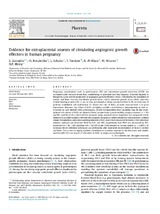Evidence for extraplacental sources of circulating angiogenic growth effectors in human pregnancy

View/
Date
2013-08-24Author
Zamudio, Stacy
Kovalenko, Olga
Echalar, Lourdes
Torricos, T
Al-Khan, A
Álvarez, M
Illsley, Nicholas P
Metadata
Show full item recordAbstract
Abastract.
Pregnancy complications such as preeclampsia (PE) and intrauterine growth restriction (IUGR) are
associated with reduced blood flow, contributing to placental and fetal hypoxia. Placental hypoxia is
thought to cause altered production of angiogenic growth effectors (AGEs), reflected in the circulation of
mother and fetus. Vascular endothelial growth factor (VEGF), placental growth factor (PlGF) and their
soluble binding protein (sFlt-1) are, in turn, postulated as being causally involved in PE via induction of
systemic endothelial cell dysfunction. To dissect the role of AGEs, accurate measurement is of great
importance. However, the values of AGEs are highly variable, contributing to heterogeneity in their association (or lack thereof) with preeclampsia. To test the hypothesis that variability may be due to peripheral cell release of AGEs we obtained blood samples from normal healthy pregnant women (n ¼ 90)
and the cord blood of a subset of their neonates using standard serum separation and compared results
obtained in parallel samples collected into reagents designed to inhibit peripheral cell activation (sodium
citrate, theophylline, adenosine and dipyridamole-CTAD). AGEs were measured by ELISA. CTAD collection
reduced maternal and fetal free VEGF by 83%, and 98%, respectively. Free PlGF was decreased by 29%,
maternal sFlt-1 by >20% and fetal sFlt-1 by 59% in the CTAD-treated vs. serum sample (p < 0.0001). In
summary blood collection techniques can profoundly alter measured concentrations of AGEs in mother
and fetus. This process is highly variable, contributes to variation reported in the literature, and renders
questionable the true impact of alteration in AGEs on pregnancy pathologies.
